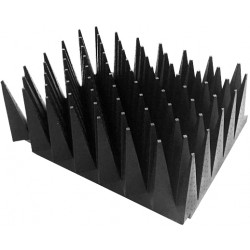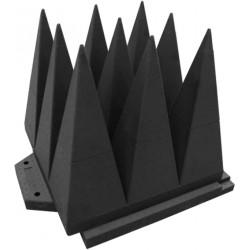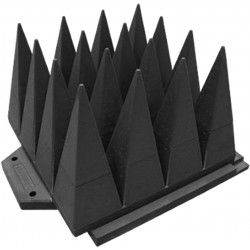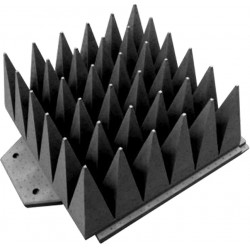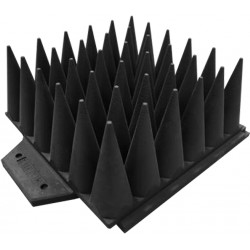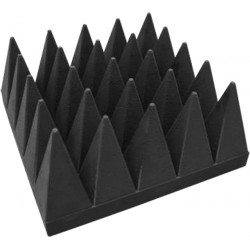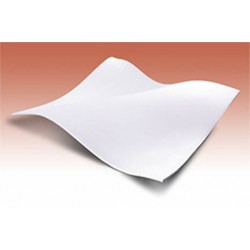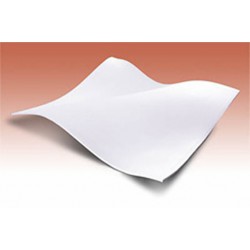No products
Product successfully added to your shopping cart
There are 0 items in your cart. There is 1 item in your cart.
RF Microwave Wedge Absorbers
- EMC Test Equipment
- Transient Generators
- RF Power Amplifiers
- DC - 300 kHz RF Amplifiers
- 10 kHz - 250 MHz RF Amplifiers
- 10 kHz - 400 MHz RF Amplifiers
- 10 kHz - 1 GHz RF Amplifiers
- 80 MHz - 1 GHz RF Amplifiers
- 1 GHz - 2 GHz RF Amplifiers
- 700 MHz - 4.2 GHz RF Amplifiers
- 1 GHz - 6 GHz RF Amplifiers
- 2 GHz - 8 GHz RF Amplifiers
- 6 GHz - 18 GHz RF Amplifiers
- 18 GHz - 40 GHz RF Amplifiers
- Pulse Amplifiers
- RF Field Strength Probes & Meters
- RF Conducted Immunity
- EMC Receivers/EMI Analyzers
- EMC Antennas
- Coupling Decoupling Networks (CDN's)
- Line Impedance Stabilization Networks (LISN's)
- RF Test Equipment
- EMC Probes
- EMC Measurement & Equipment Software
- Power Supplies
- Electrical Safety Analyzers
- High Precision Laboratory Power Analyzers & Meters
- Anechoic Chambers
- Over-the-Air (OTA) Test Chambers
- EMI RF Shielded Tent Enclosures
- RF Shielded Rooms
- EMC Absorber
- Positioning Equipment
- EMC/EMI Test Setup
- GTEM Cells / TEM Cells
- Reverberation Chambers
- Used RF Anechoic Chambers
- EMC Chamber Filters
- EMC Chamber Shielding Gaskets
- RF Shielded Doors
- Anechoic Chamber Accessories
- Fully Anechoic (FAR) Test Chambers
- Manufacturers
- 3ctest
- AE Techron
- AH Systems
- Amplifier Research
- Boonton
- Com-Power
- Diamond Engineering
- EM Test (Ametek CTS)
- EMC Partner
- EMC Test Design
- Empower High Power RF Amplifiers
- ETS-lindgren
- Log Periodic Dipole Array Antenna
- Near Field Probe Sets
- Double Ridge Horn Antennas
- Biconical Antennas
- Quad Ridge Horn Antennas
- Electric Field Probes
- GTEM's
- Positioners & Tripods
- Loop Antennas
- Biconilog Antennas
- LISN's (Line Impedance Stabilization Network)
- Shielded Enclosures/Rooms
- Monopole Antennas
- Field Generating Antennas
- Fischer Custom Communications
- Haefely Hipotronics
- Haefely EFT/Burst Immunity Test Systems
- Haefely Surge Combination Wave Test Systems
- Haefely Surge Damped Oscillating Wave Test Systems
- Haefely Electrostatic Discharge Test Systems (ESD)
- Haefely Surge Ring Wave Test Systems
- Haefely Surge Telecom Wave Test Systems
- Haefely Magnetic Field Test Systems
- Haefely CDN's (Coupling/Decoupling Networks)
- IFI Amplifiers
- Keysight (Agilent)
- MVG - Microwave Vision Group
- PMM / Narda
- Rohde & Schwarz RF Test Equipment
- Rohde & Schwarz Broadband RF Amplifiers
- Rohde & Schwarz Spectrum Analyzers
- Rohde & Schwarz Compliant EMI Test Receivers
- Rohde & Schwarz Isotropic RF Probes
- Rohde & Schwarz RF Signal Generators
- Rohde & Schwarz RF Switches
- Rohde & Schwarz Oscilloscopes
- Rohde & Schwarz RF Power Meters
- Rohde & Schwarz RF Power Sensors
- Schloder
- Schwarzbeck Mess-Elektronik
- Schwarzbeck Antennas
- Schwarzbeck Automotive Antennas
- Schwarzbeck Broadband Horn Antennas
- Schwarzbeck Biconical Antennas
- Schwarzbeck Logarithmic Periodic Broadband Antennas
- Schwarzbeck Stacked Log-Periodic Broadband Antennas
- Schwarzbeck Biconic Log-Periodic Antennas
- Schwarzbeck Dipole Antennas
- Schwarzbeck Rod Antennas
- Schwarbeck Antenna Baluns / Holders
- Schwarzbeck LISN Line Impedance Stabilisation Networks
- Schwarbeck Decoupling & Absorbing Clamps
- Schwarzbeck Field Probes
- Schwarzbeck Helmholtz Coils
- Schwarzbeck Antenna Masts
- Schwarzbeck Coupling/Decoupling Networks
- Schwarzbeck Antennas
- Solar Electronics
- Teseq (Schaffner)
- Teseq Automotive Transient Generators
- Teseq RF Test Equipment
- Teseq EFT/Burst Generators
- Teseq RF Immunity Generators
- Teseq ESD Guns
- Teseq Surge Generators
- Teseq Harmonics & Flicker Solutions
- Teseq Dips, Interrupts & Variations Equipment
- Teseq Ring Wave Generators
- Teseq Oscillatory Waves Generators
- Teseq Absorbing Clamps / Ferrite Tube
- Teseq EMC Antennas
- Teseq Current Probes
- Teseq Coupling Networks
- Thermo Keytek
- Vicreate
- Compliance Standards
- International (IEC/EN)
- EN/IEC 61000-3-2
- EN/IEC 61000-3-3
- IEC 61000-3-11
- IEC / EN 610000-3-12
- EN/IEC 61000-4-2
- EN/IEC 61000-4-3
- EN/IEC 61000-4-4
- EN/IEC 61000-4-5
- EN/IEC 61000-4-6
- EN/IEC 61000-4-7
- EN/IEC 61000-4-8
- EN/IEC 61000-4-9
- EN/IEC 61000-4-10
- EN/IEC 61000-4-11
- EN/IEC 61000-4-12
- EN/IEC 61000-4-16
- EN/IEC 61000-4-18
- EN/IEC 61000-4-19
- EN/IEC 61000-4-20
- EN/IEC 61000-4-21
- EN/IEC 61000-4-29
- EN/IEC 61000-4-31
- IEC 61000-4-39
- EN/IEC 62132
- SEMI F47 Voltage Sag Immunity
- Product Standards
- Military & Aerospace Standards
- Automotive EMC Standards
- CISPR Standards
- Telecom Testing
- ANSI/IEEE Standards
- FCC Part 15
- FCC Part 30
- International (IEC/EN)
- Application/Test Type
- Radiated Immunity
- Bulk Current Injection Testing
- RF Emissions Testing
- Conducted Immunity
- Conducted Emissions
- Antenna Pattern Measurement
- CE Mark Testing
- Intentional Radiator Testing
- Pulsed HIRF Radar
- Over-the-Air (OTA) Testing
- 5G Test Solutions
- Automotive EMC
- SAR Measurement Equipment
- Radiated Emissions
- Battery Simulator Test Equipment
- Services
- Clearance
Viewed products
-

Cuming Microwave C-RAM...
RTV silicone rubber Supplied in...
-

Amplifier Research...
Fresh Output Curve Provided Output:...
Cuming Microwave C-RAM PAINT Magnetic Iron, Epoxy and Silicone Sprayables
New
- RTV silicone rubber
- Supplied in pourable liquid kit form
- Will cure into an elastomeric solid
- With excellent physical, thermal and;
- Electrical properties
Test Equipment Description
The C-RAM PAINT are available in a urethane, silicone, or epoxy binder system. They are all room temperature curable systems. Simply designate the binder system when ordering. C-RAM PAINT comes in two loadings, High Permeability, and Very High Permeability. Both loadings can be ordered in any of the three binder systems. C-RAM HP and C-RAM VHP are also available in sheet form in both the silicone and urethane versions. C-RAM Paint can be supplied loaded to duplicate performance of the FLX product line to provide resonant performance. C-RAM HP and VHP, when used in their base form minus solvent, can be molded into complex shapes with special tooling and dispensing equipment; consult the factory for specific details. Customer specified loadings are available on special request.
APPLICATIONS
C-RAM Magnetic Paint is ideally suited for broadband, specular, off-normal, and surface wave attenuation. Silicone or urethane binder systems should be selected for dynamic applications, epoxy should be selected when a hard coating is needed or chemical resistance is desired. C-RAM Magnetic Paints will provide high levels of attenuation in multi-bounce, offnormal, or travelling wave applications. CRAM VHP is particularly effective at very high angles of incidence. For proper operation CRAM paints should be applied to a reflective surface.
| BINDER SELECTION | ||
| SILICONE | ||
| Typical Hardness-Shore A | 60-70 | |
| Temperature Range | -80 to 400 °F | |
| Advantages | Excellent heat resistance, good flexibility at low temperature, excellent ozone and sunlight. | |
| Disadvantages | Silicone adhesives are necessary to bond. Fair resistance to solvents, poor abrasion resistance. | |
| Typical Use | The elastomer of choice for high and low temperature applications. | |
| URETHANE | ||
| Typical Hardness Shore A | 80-85 | |
| Temperature Range | -80 to 275 °F | |
| Advantages | Excellent abrasion resistance and tear, good weather resistance, excellent tensile strength and elongation. | |
| Disadvantages | poor resistance to hot water, acids, and alkalis. | |
| Typical Use | Tough and durable urethane is the most popular elastomeric coating. Urethanes are readily painted and work well in most applications. | |
| EPOXY | ||
| Typical Hardness, Shore D | 70-80 | |
| Temperature Range | -40 to 350 °F | |
| Advantages | Epoxy coatings are hard and have excellent chemical resistance. | |
| Disadvantages | Can be brittle and prone to cracking in dynamic applications. | |
| DENSITY OF APPLIED COATING | ||
| HP | VHP | |
| Density | 3.33 g/cm3 | 3.92 g/cm3 |
| MIXING C-RAM PAINT BASES BY WEIGHT | ||
| HP | VHP | |
| A to B by wt. | A to B by wt. | |
| Silicone | 98.18: 1.81 | 98.63: 1.36 |
| Urethane | 98.18: 1.81 | 98.63: 1.36 |
| Epoxy 9 | 7.33: 2.66 | 98.00: 2.00 |
DILUTING FOR BRUSHING
In general, very small amounts of solvent are required, 2-5 grams for every 100 grams of C-RAM Paint mix, to thin to a brushable consistency. A 50/50 blend of MEK/MIBK blend is the solvent of choice for silicone and urethane, lacquer thinner is used for thinning of epoxy. It will take approximately 5-15 minutes for the urethane and silicone coatings to tack up and be ready to accept a second coating application. Be careful not to mix too much base, one should mix only enough for two coating applications. Solvent will slow the reaction time and prolong potlife. As each application is different, small pieces should be coated prior to large area applications.
DILUTING FOR PAINTING
C-RAM paint mixture will require more solvent to dilute to a sprayable consistency. For every 100 grams of mix, dilute with 20 +/- 5 grams, 50/50 blend of MEK/MIBK for silicone and urethane, lacquer thinner for epoxy. It will take 15 minutes for each spray coating of silicone and urethane to tack up and be ready for a second coating, approximately 30 minutes for the epoxy. Be careful not to apply too much or the coating will run. Potlife is approximately 30 minutes for silicone and urethane, 60 minutes for epoxy.
ELECTRICAL PERFORMANCE
The graphs below show typical reflectivity of HP and VHP epoxy and silicone based coatings on a metal plate:
 |  |
| HP Epoxy Paint | VHP Silicone Paint |


